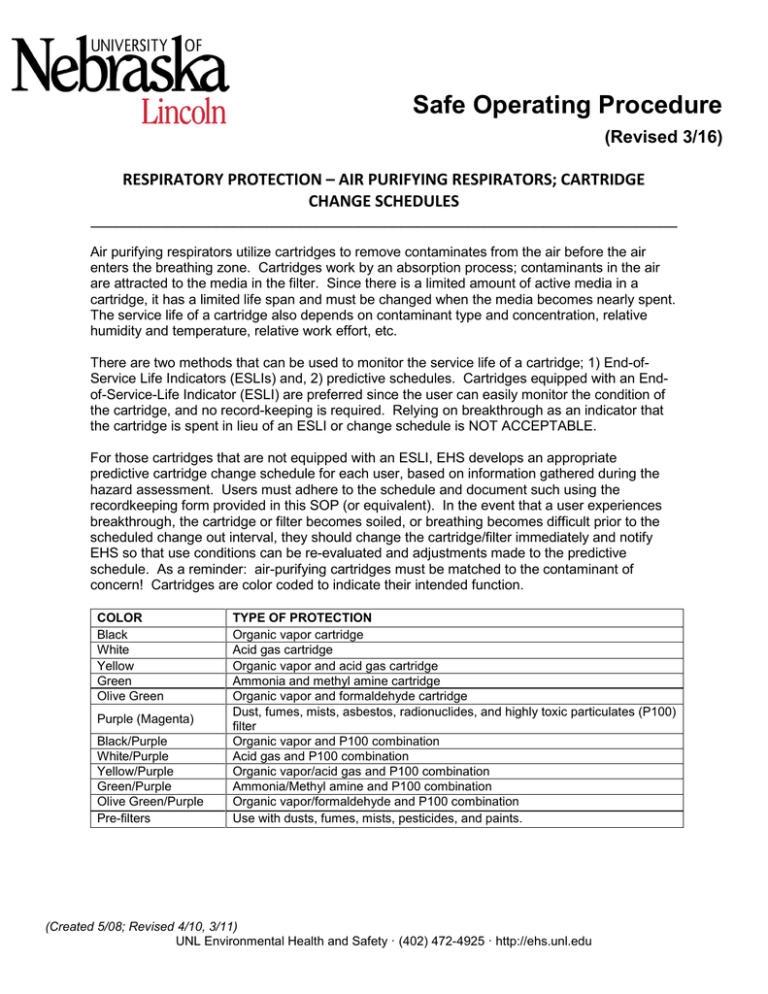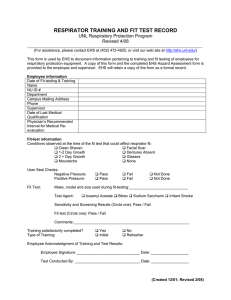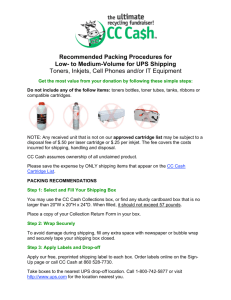Safe Operating Procedure (Revised 3/16) RESPIRATORY PROTECTION – AIR PURIFYING RESPIRATORS; CARTRIDGE
advertisement

Safe Operating Procedure (Revised 3/16) RESPIRATORY PROTECTION – AIR PURIFYING RESPIRATORS; CARTRIDGE CHANGE SCHEDULES ______________________________________________________________________ Air purifying respirators utilize cartridges to remove contaminates from the air before the air enters the breathing zone. Cartridges work by an absorption process; contaminants in the air are attracted to the media in the filter. Since there is a limited amount of active media in a cartridge, it has a limited life span and must be changed when the media becomes nearly spent. The service life of a cartridge also depends on contaminant type and concentration, relative humidity and temperature, relative work effort, etc. There are two methods that can be used to monitor the service life of a cartridge; 1) End-ofService Life Indicators (ESLIs) and, 2) predictive schedules. Cartridges equipped with an Endof-Service-Life Indicator (ESLI) are preferred since the user can easily monitor the condition of the cartridge, and no record-keeping is required. Relying on breakthrough as an indicator that the cartridge is spent in lieu of an ESLI or change schedule is NOT ACCEPTABLE. For those cartridges that are not equipped with an ESLI, EHS develops an appropriate predictive cartridge change schedule for each user, based on information gathered during the hazard assessment. Users must adhere to the schedule and document such using the recordkeeping form provided in this SOP (or equivalent). In the event that a user experiences breakthrough, the cartridge or filter becomes soiled, or breathing becomes difficult prior to the scheduled change out interval, they should change the cartridge/filter immediately and notify EHS so that use conditions can be re-evaluated and adjustments made to the predictive schedule. As a reminder: air-purifying cartridges must be matched to the contaminant of concern! Cartridges are color coded to indicate their intended function. COLOR Black White Yellow Green Olive Green Purple (Magenta) Black/Purple White/Purple Yellow/Purple Green/Purple Olive Green/Purple Pre-filters TYPE OF PROTECTION Organic vapor cartridge Acid gas cartridge Organic vapor and acid gas cartridge Ammonia and methyl amine cartridge Organic vapor and formaldehyde cartridge Dust, fumes, mists, asbestos, radionuclides, and highly toxic particulates (P100) filter Organic vapor and P100 combination Acid gas and P100 combination Organic vapor/acid gas and P100 combination Ammonia/Methyl amine and P100 combination Organic vapor/formaldehyde and P100 combination Use with dusts, fumes, mists, pesticides, and paints. (Created 5/08; Revised 4/10, 3/11) UNL Environmental Health and Safety · (402) 472-4925 · http://ehs.unl.edu RESPIRATOR CARTRIDGE LOG Use the following log form to determine when respirator cartridges have reached their end of service and should be changed for new cartridges. NOTE: This log is only for air purifying respirators fitted with chemical vapor cartridges. It is not meant for use with HEPA filters. DATE AMOUNT OF TIME RESPIRATOR WORN (minutes) CUMULATIVE TIME (minutes) WHERE USED Time 1+ Time 2+ Time 3, etc. CHEMICAL NAME 1. 2. 3. 4. 5. 6. 7. 8. 9. 10. 11. 12. TOTAL ( ) Minutes = Time To Change Cartridges Each time you use a particular cartridge (or set of cartridges), record the time it is used under "Amount of Time;" add that amount to the time in the "Cumulative Time" column. Once the designated maximum use time (as defined in your unique cartridge change schedule established by EHS) is reached, retire the cartridge and replace with a new part. Seal the spent cartridge in a plastic bag and tag for collection by EHS. Indicate the potential contaminants on the collection tag. See EHS SOP, Hazardous/Radioactive Material Collection Procedures. (Created 5/08; Revised 4/10, 3/11) UNL Environmental Health and Safety · (402) 472-4925 · http://ehs.unl.edu



